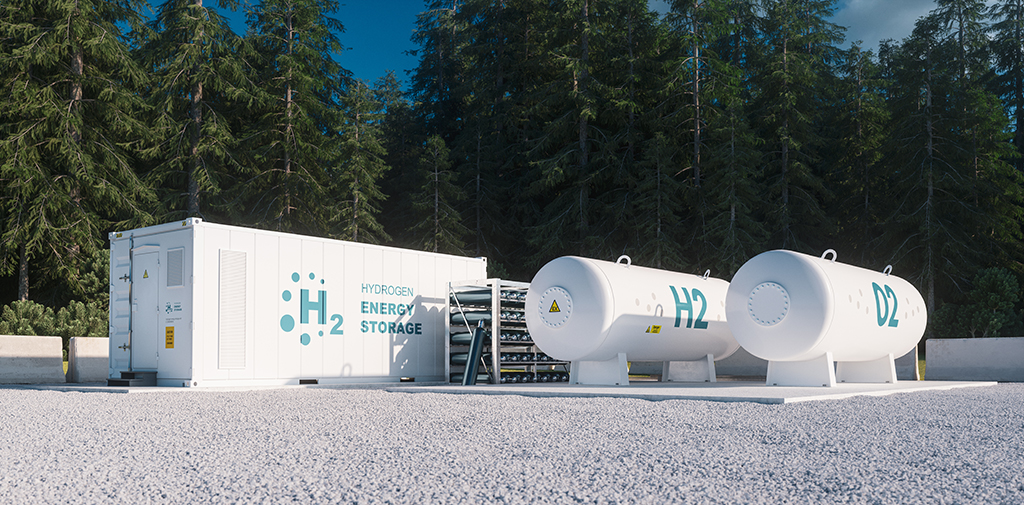Green hydrogen can contribute to the decarbonisation of transport and industry as a storage technology for sustainable energy.
The world agreed in the Paris Climate Agreement that the economy should become greenhouse neutral between 2050 and 2100. A fundamental transformation of the energy system is necessary to achieve these ambitious goals. Hydrogen plays an important role here, and not only in the transport sector. The Federal Government wants to make Germany a technological pioneer with its National Hydrogen Strategy. Research and companies are among the world leaders in hydrogen technologies, and complex industrial plants are part of the core competence of German plant engineering. HEROSE is deeply involved in the subject of hydrogen and can offer high-quality and reliable solutions in the cryogenic range, even at high pressures. The company has already equipped hydrogen projects.
The Point of Originin in the field of green hydrogen

Green electricity from wind turbines or solar plants is always available when nature wants it to be. Unfortunately, when the electricity grids are at capacity, wind turbines often have to be shut down. Energy is wasted here, because there is still no efficient storage option for large quantities of electricity. On the one hand, energy producers have to be guided by nature in their production. On the other hand, energy should also be available when it is neither blowing nor the sun is shining. This is where hydrogen technology comes into play: since we will soon need to store more energy than ever before, there is hardly any way around utilising hydrogen as an energy storage medium.
Green Hydrogen as an Energy Storage Medium
Molecular hydrogen is an odourless, volatile gas that does not occur in pure form on our planet. Hydrogen is the first element in the periodic table and the first to be formed after the Big Bang. It occurs predominantly as a compound and has a high energy density. A car can travel 100 kilometres on one kilogram of hydrogen. Pure hydrogen is produced by electrolysis: in an electrolyser, water (H2O) is subjected to electricity so that hydrogen (H2) and oxygen (O2) are split from each other. When this electrolysis takes place with electricity from wind power or photovoltaics, it is called green hydrogen.
The Pillars of the Energy Revolution
The energy revolution requires a revolution in our energy storage systems. Green technologies like wind power and solar energy can generate more and more energy, but not necessarily at the very moment it is needed by industry, transport and the heating sector. The storage possibilities on the required scale do not yet exist. Hydrogen produced with green energy can make an important contribution to climate protection, because only pure water is produced during its conversion back into electrical energy. Hydrogen can be a pillar to enable the storage of this energy and make it available for use in various forms: depending on requirements, hydrogen can be further processed into synthetic natural gas, diesel, petrol or paraffin.
Green hydrogen – two Examples
e-Farm, Germany
In Reußenköge near Husum, GP Joule is building Germany’s largest complete supply chain for “green” hydrogen. As part of the “e-Farm” project, which is being funded by the Federal Ministry of Transport with eight million euros, GP Joule is building five electrolysis plants located directly next to wind farms. The hydrogen produced there will be sold at two filling stations in Husum and Niebüll. The project also includes two buses and five cars for public use. The waste heat generated during the electrolysis of hydrogen is to be fed into municipal heating networks.
Hydrosol Plant, Spain
In Spain, the German Aerospace Center (DLR) unveiled in November 2018 the largest solar thermal water splitting plant to date. It is located near the Andalusian city of Almeria and is called “Hydrosol-Plant”. Mirrors, with a total surface area of 3,500 square metres, direct sunlight onto a reactor and heat it up to 1,400 degrees Celsius. Ceramic foams in the reactor lose oxygen in the process. In a second step, water vapour is allowed to enter the machine, which in turn releases oxygen to the foams, leaving hydrogen.
What is the international situation with green hydrogen?
Green hydrogen can be the important pillar for so-called sector coupling – the networking of the energy sector with industry. Many countries are showing strong commitment: Sweden, Norway and the Netherlands are backing hydrogen, and Japan and Australia are also promoting the alternative fuel. Governments from Washington to Riyadh are investing a lot of money in research and pilot projects to make hydrogen more competitive. The four northern German states of Schleswig-Holstein, Mecklenburg-Western Pomerania, Lower Saxony and Hamburg launched the “Northern German Hydrogen Strategy” in 2019 and the German government unveiled national funding in cooperation with four federal ministries. The hydrogen future has just begun, and it is exciting.
Hydrogen – a hot topic at HEROSE
As an experienced valve manufacturer, HEROSE is deeply involved with the topic of hydrogen and its many possibilities.
The challenges in handling hydrogen lie on the one hand in the high pressures of up to 1000 bar, and on the other hand in the storage temperatures of -255 °Celsius.
Mario Esche, Head of Marketing and Product Management
To guarantee absolute sealing, bellows are used and fittings are milled from solid material – V4A, for example. Managing director, Dirk Zschalich, confirms: “We have mastered the technology and have already equipped the first projects in the hydrogen sector”.
Top Entry Valve – Type 01470
High pressure safety valves – Type 06810 and 06820
Photos: Miha Creative, malp – Adobe Stock
Did you enjoy this article?
For further information and background reports on industrial valves and applications, please subscribe to the complimentary HEROSE newsletter.
Subscribe


 Read the current digital customer magazine now!
Read the current digital customer magazine now!
